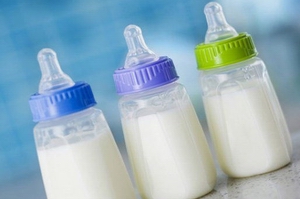 le published last week in BMC Pediatrics, researchers from Keele University in Staffordshire, U.K., put the infant formula industry on notice. In their second research article on aluminum contamination in infant formula, the team of researchers measured the aluminum content of 10 ready-to-drink and 20 powdered infant formulas and found that some brands can contain 100 times more aluminum than breast milk.
le published last week in BMC Pediatrics, researchers from Keele University in Staffordshire, U.K., put the infant formula industry on notice. In their second research article on aluminum contamination in infant formula, the team of researchers measured the aluminum content of 10 ready-to-drink and 20 powdered infant formulas and found that some brands can contain 100 times more aluminum than breast milk.All of the infant formula samples contained at least two times the recommended level of aluminum for drinking water in the European Union, and 14 of the samples exceeded the maximum admissible level for drinking water.
The authors point out that, while the U.K. Food Standards Agency and the European Food Safety Authority have argued that the daily intake of aluminum from infant formulas is unlikely to exceed the tolerable weekly intake set by the joint United Nations Food and Agriculture Organization/World Health Organization Expert Committee on Food Additives, that value was determined for adults and was not based on studies conducted on human subjects.
The U.K. researchers found that the aluminum content of liquid infant formulas was highest in two products contained in plastic bottles with an aluminum seal between the cap and the product. They suggested that the seal could be a significant source of aluminum contamination in those products, but they also noted that packaging is only one potential source of aluminum contamination.
When testing powdered formulas, the researchers found that one brand that supplied both the least and most contaminated of non-soya-based milk powders appeared to use the same packaging materials. Soya is a significant source of aluminum contamination in infant formulas, according to the authors.
The authors argue that, despite their 2010 publication of the aluminum content of 15 well-known infant formula products, manufacturers have not yet addressed the problem. They conclude that regulatory and other non-voluntary methods are required to reduce the aluminum content of infant formulas and prevent chronic exposure of infants to dietary aluminum.
In its Public Health Statement for Aluminum, the U.S. Centers for Disease Control and Prevention states:
• An average adult in the United States consumes about 7-9 mg of aluminum per day in food.
• The concentration of aluminum in natural waters (e.g., ponds, lakes, streams) is generally below 0.1 milligrams per liter (mg/L).
• People generally consume little aluminum from drinking water. Water is sometimes treated with aluminum salts while it is processed to become drinking water. But, even then, aluminum levels generally do not exceed 0.1 mg/L. Several cities have reported concentrations as high as 0.4–1 mg/L of aluminum in their drinking water.
• Oral exposure to aluminum is usually not harmful. Some studies show that people exposed to high levels of aluminum may develop Alzheimer’s disease, but other studies have not found this to be true. We do not know for certain that aluminum causes Alzheimer’s disease.
• Some people who have kidney disease store a lot of aluminum in their bodies. The kidney disease causes less aluminum to be removed from the body in urine. Sometimes such people developed bone or brain diseases that doctors suspect were caused by the excess aluminum.
• Although over-the-counter oral products containing aluminum are considered safe in healthy individuals at recommended doses, adverse effects have been observed following long-term use in some individuals.
• Brain and bone disease caused by high levels of aluminum in the body have been seen in children with kidney disease. Bone disease has also been seen in children taking some medicines containing aluminum. In these children, the bone damage is caused by aluminum in the stomach preventing the absorption of phosphate, a chemical compound required for healthy bones.
• Aluminum is found in breast milk, but only a small amount of this aluminum will enter the infant’s body through breastfeeding. Typical aluminum concentrations in human breast milk range from 0.0092 to 0.049 mg/L. Aluminum is also found in soy-based infant formula (0.46–0.93 mg/L) and milk-based infant formula (0.058–0.15 mg/L).
• We do not know if aluminum will cause birth defects in people. Birth defects have not been seen in animals.
• Very young animals appeared weaker and less active in their cages and some movements appeared less coordinated when their mothers were exposed to large amounts of aluminum during pregnancy and while nursing. In addition, aluminum also affected the animal’s memory. These effects are similar to those that have been seen in adults.
• It does not appear that children are more sensitive to aluminum than adult animals are.





